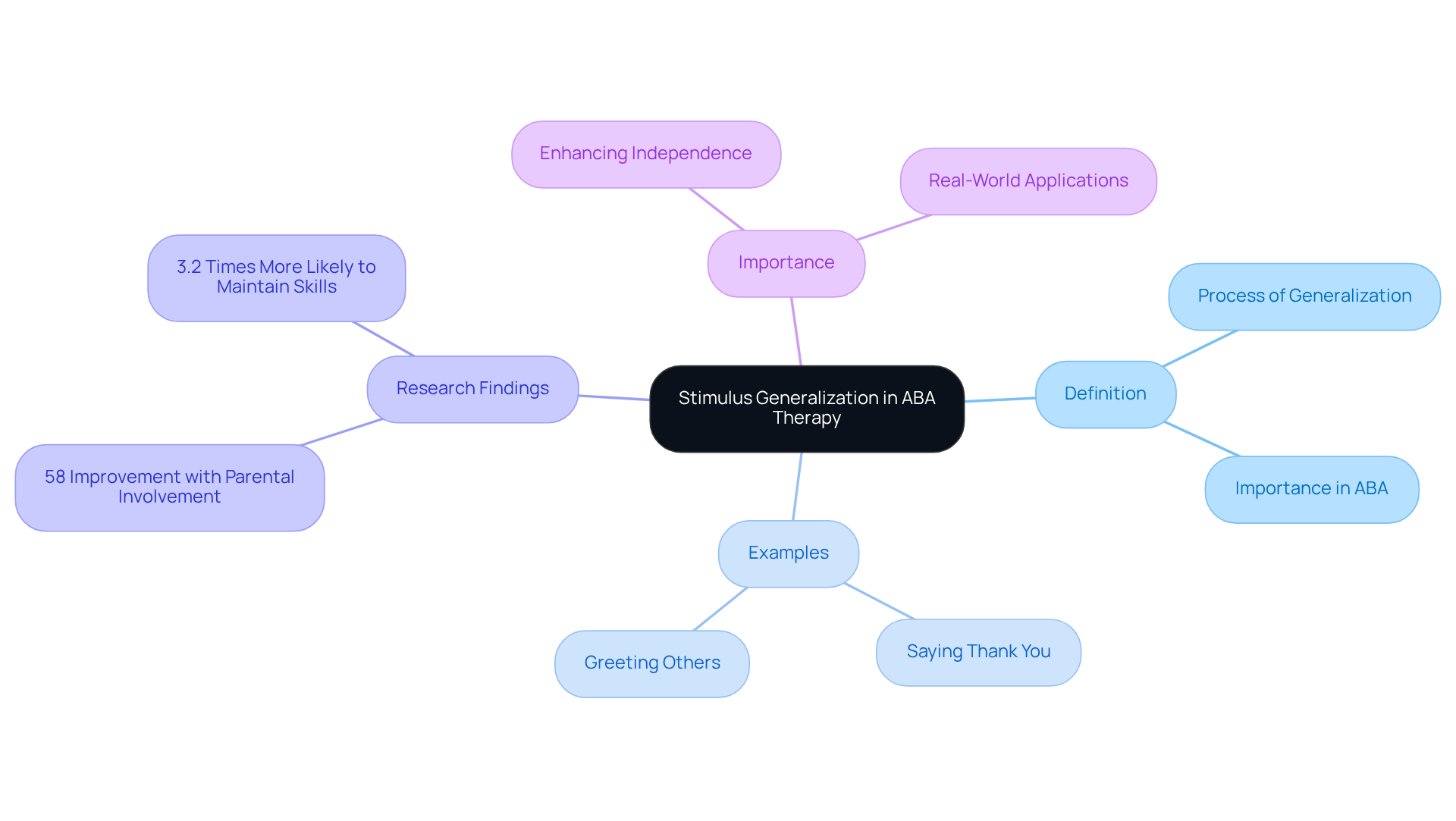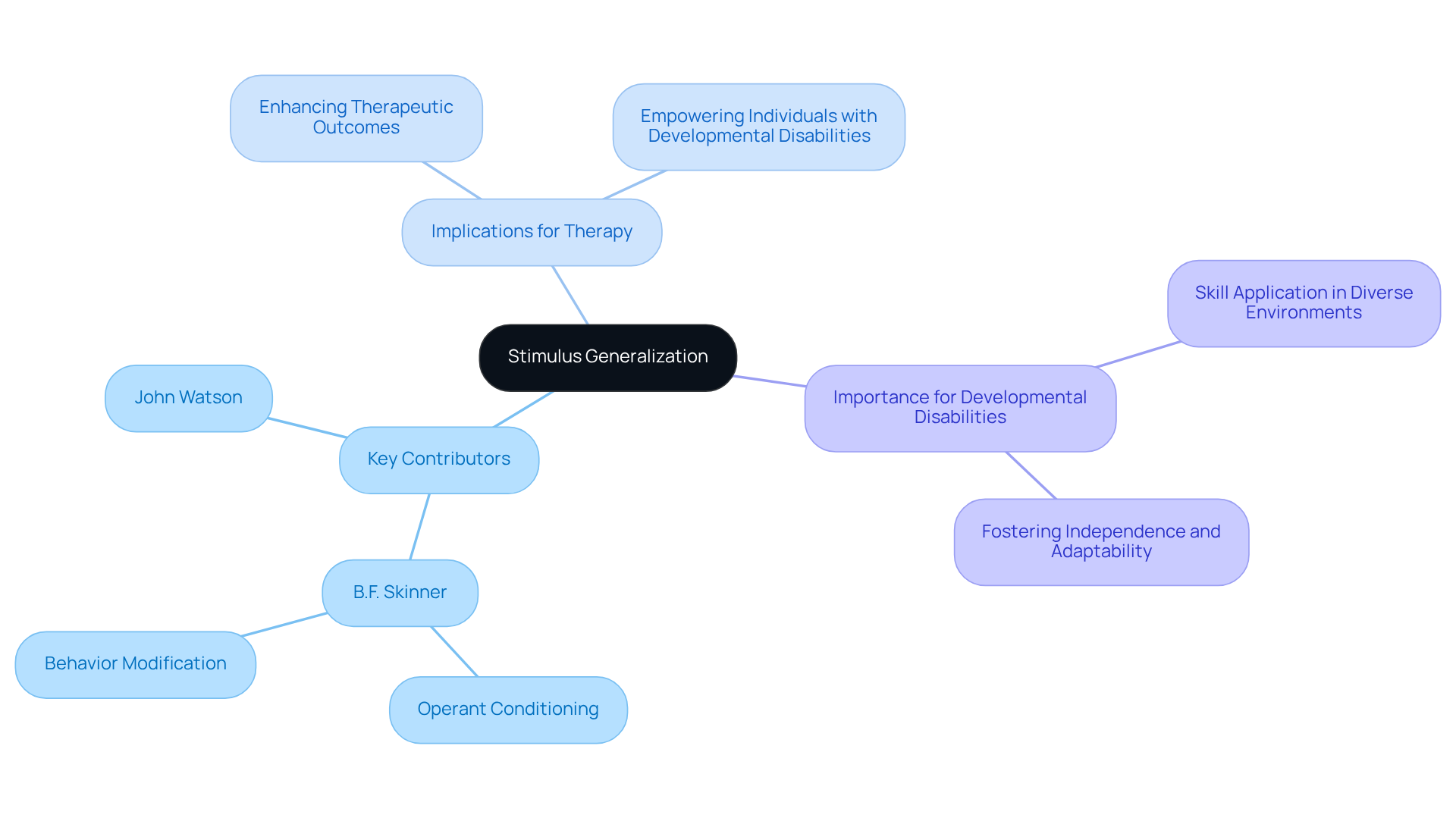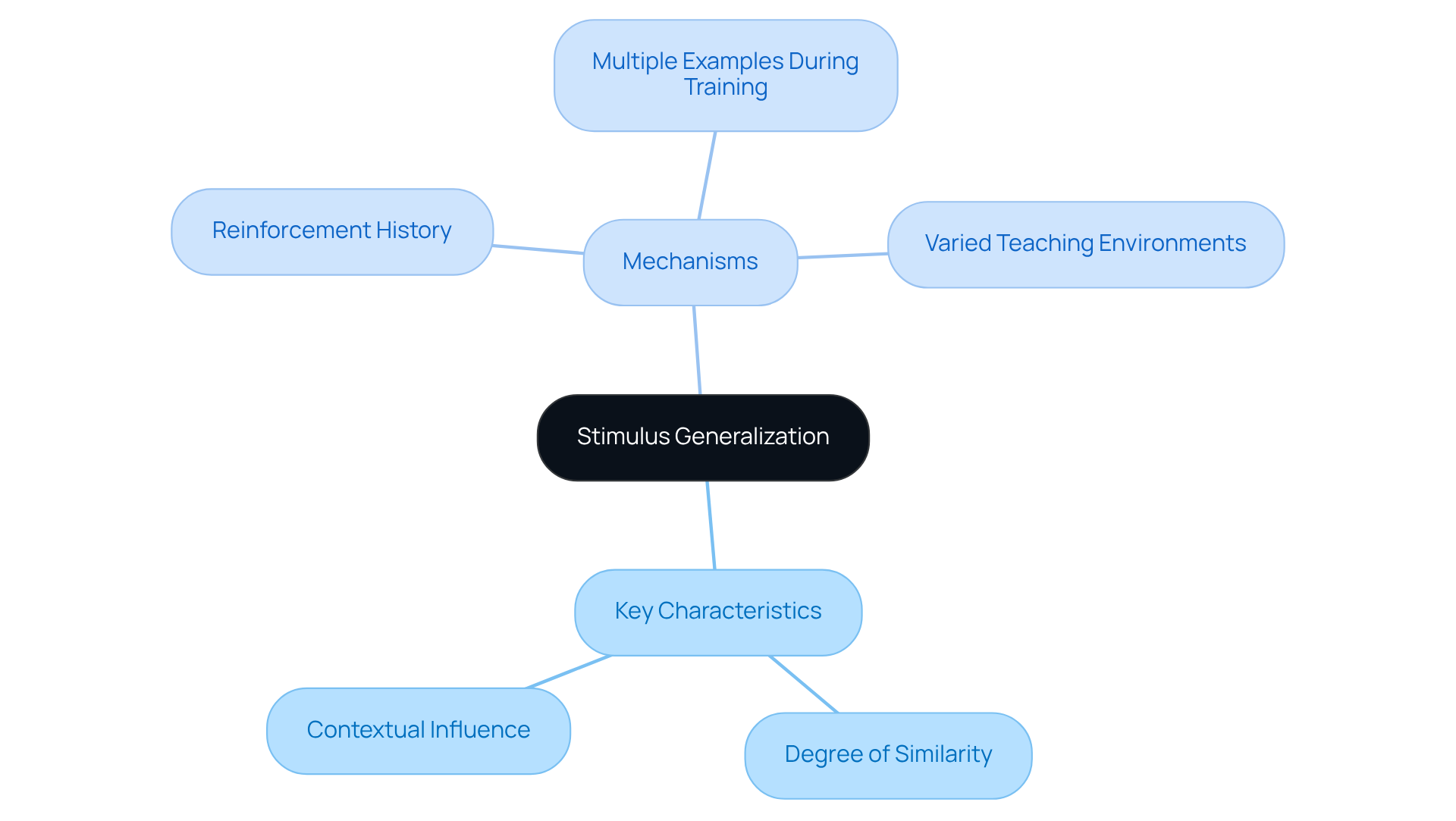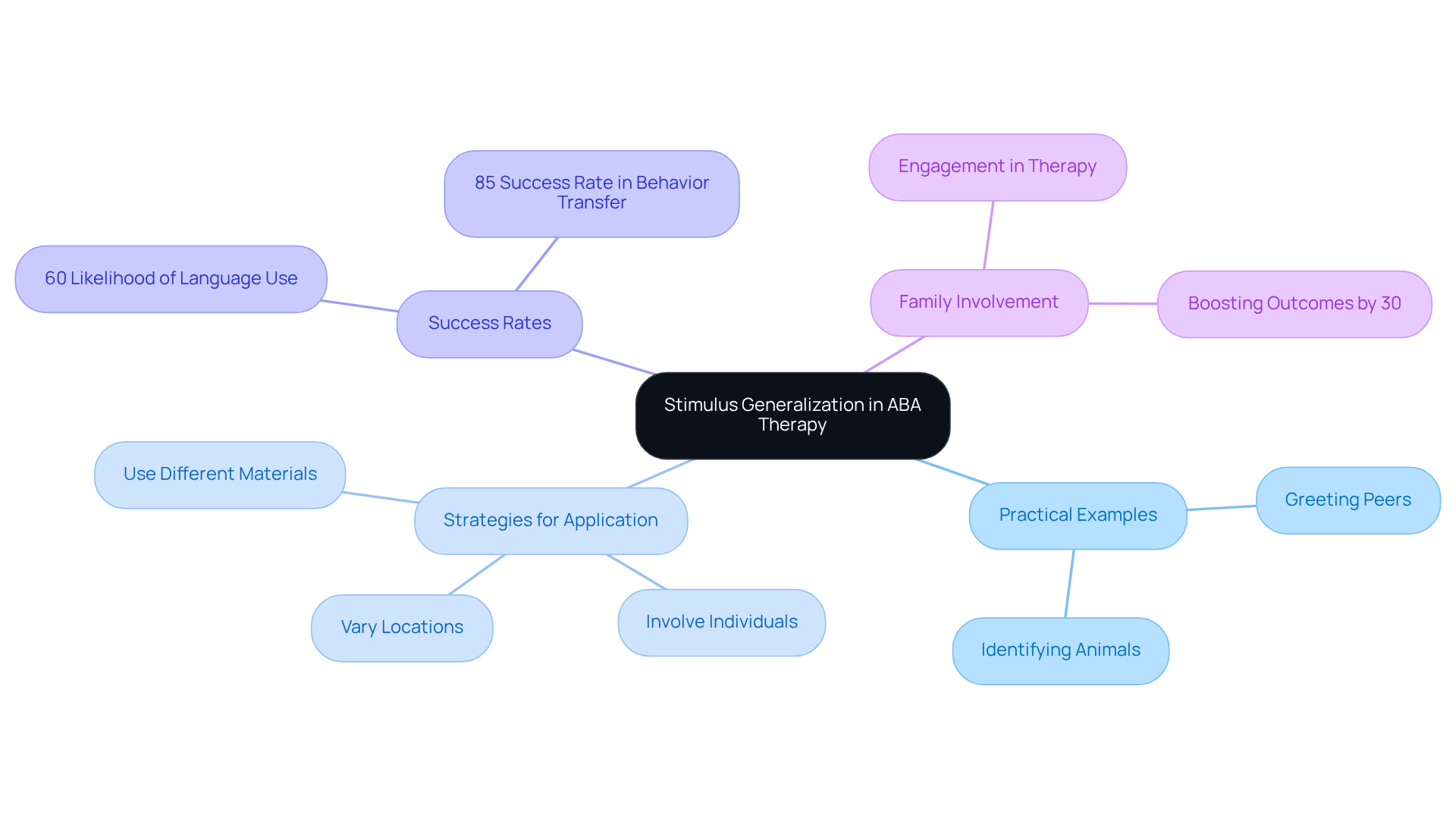September 10, 2025

Stimulus generalization in ABA therapy is a critical process whereby a behavior, reinforced in the presence of a specific stimulus, manifests in the presence of similar stimuli. This phenomenon enables learned behaviors to be effectively applied across various real-world contexts. Notably, research underscores the significance of teaching skills in diverse environments, as it markedly enhances the likelihood that these behaviors will be utilized outside of structured settings. Ultimately, this approach fosters greater independence for individuals with autism, making it essential for practitioners to integrate these strategies into their methodologies.
Understanding how behaviors extend beyond specific situations is crucial in Applied Behavior Analysis (ABA) therapy, particularly through the lens of stimulus generalization. This concept not only enhances therapeutic effectiveness but also empowers individuals, especially those with autism, to apply learned skills in diverse real-world contexts.
However, a significant challenge persists: how can practitioners ensure that these skills are not confined to clinical settings but are effectively transferred to everyday life?
Exploring the definition, significance, and practical applications of stimulus generalization reveals the key to unlocking greater independence and adaptability for those in therapy.
The stimulus generalization definition in Applied Behavior Analysis (ABA) therapy refers to the critical process where an action reinforced in the presence of a specific stimulus also occurs in the presence of similar stimuli. This phenomenon is essential for ensuring that the stimulus generalization definition is applied, allowing acquired actions to extend beyond a single context and be utilized in various situations. For instance, when a child learns to say 'thank you' upon receiving a toy, they may also begin to express gratitude when given other items, such as food or compliments. This ability to generalize actions is a key aspect of the stimulus generalization definition, which significantly enhances the effectiveness of therapeutic interventions, making them more applicable in real-world scenarios.
Research underscores the significance of stimulus transfer in behavior modification. A notable study revealed that youngsters whose parents received structured training in ABA techniques exhibited a 58% improvement in the maintenance of skills compared to those without parental involvement. Furthermore, children who achieve robust overall outcomes are 3.2 times more likely to sustain their abilities six months post-treatment, illustrating the lasting benefits of effective strategies for broad application.
Everyday life is filled with real-world examples that illustrate the stimulus generalization definition. Consider a young person who learns to greet their therapist with 'hello'; they should similarly be able to greet peers and family members in less structured environments. The capacity to transfer learned behaviors, as described by the stimulus generalization definition, is not merely advantageous; it is vital for fostering independence and enhancing the quality of life for individuals with autism. As highlighted in the literature, the primary aim of ABA intervention is to ensure that skills acquired in structured settings translate into real-world proficiency, which illustrates the stimulus generalization definition, enabling young individuals to navigate their surroundings effectively. As Yitz Dien aptly notes, 'A typical example is a child who has learned to follow instructions during a treatment session.'
In conclusion, the importance of the stimulus generalization definition in the context of ABA treatment cannot be overstated. It serves as a cornerstone of effective behavior modification, guaranteeing that therapeutic gains are not limited to clinical settings but are applicable in the broader context of daily life. By emphasizing broader applications, we honor the ultimate goal of ABA therapy: assisting children with autism in acquiring the skills necessary to thrive in their natural environments.

The stimulus generalization definition serves as a cornerstone in early behavioral psychology, particularly through the groundbreaking contributions of B.F. Skinner and John Watson. Skinner's extensive research on operant conditioning laid a robust framework for understanding how behaviors can be shaped and modified through reinforcement. His findings revealed that behaviors could transcend the specific stimuli present during training, which aligns with the stimulus generalization definition and holds significant implications for contemporary ABA therapy.
Research underscores that the stimulus generalization definition is crucial for individuals with developmental disabilities, as it fosters greater independence and adaptability across various life situations. By teaching skills in diverse environments, practitioners can enhance the likelihood that these behaviors will be effectively applied in real-world contexts. This comprehension is essential, as it not only elevates therapeutic outcomes but also bolsters the overarching goal of empowering individuals to navigate their environments with assurance.

Key characteristics of stimulus transfer relate to the degree of similarity between the original stimulus and the new stimuli, as well as the context in which the behavior manifests, which illustrates the stimulus generalization definition. Mechanisms that facilitate the derivation of broader principles include:
For instance, when a child learns to respond to a red ball during treatment, the introduction of various colored balls can significantly extend the response to all balls. This method not only reinforces the behavior but also fosters flexibility in responding to similar stimuli, aligning with the stimulus generalization definition—an essential aspect for effective social interactions and daily living skills.

Practical examples of stimulus transfer in ABA therapy demonstrate its effectiveness in skill acquisition across various settings. For instance, a therapist may initially instruct a young person to greet peers by saying 'hello' in a controlled environment. To facilitate generalization, the therapist can then practice greetings in diverse locations, such as at home, in the park, or during community outings. This method not only strengthens the skill but also assists the young person in adapting to various social contexts.
Another illustrative example involves teaching a young person to identify animals. If the young one learns to identify a dog in an illustrated book, the therapist can enhance this learning by presenting actual dogs in different settings, such as at a friend's residence or during a trip to a pet shop. This approach reinforces the individual's capacity to generalize the skill beyond the initial learning context.
The success rates of broadening methods in ABA treatment are remarkable. Research shows that youngsters who engage in diverse practice environments are considerably more inclined to utilize acquired skills in real-life circumstances. For instance, children are 60% more likely to use new language skills in different settings when learned via Natural Language Acquisition (NLA). Furthermore, parents involved in ABA practices observe more than an 85% success rate in behavior transfer, highlighting the efficiency of these methods.
To effectively apply the stimulus generalization definition in treatment sessions, practitioners can employ strategies such as varying the locations, individuals, and materials used during practice. Involving family members in the learning process can enhance application, as engaging families in treatment can boost outcomes by 30%. This collaboration allows caregivers to reinforce skills in everyday situations.
By systematically encouraging generalization and utilizing data collection to monitor progress, therapists can lead to more robust and functional skill acquisition, ultimately enhancing the quality of life for individuals receiving ABA therapy.

The concept of stimulus generalization in ABA therapy is pivotal, ensuring that learned behaviors extend beyond controlled environments into everyday life. This essential process empowers individuals to apply skills across various contexts, ultimately fostering independence and enhancing their overall quality of life.
Key insights throughout the article underscore the significance of this phenomenon. Its historical roots in behavioral psychology, the mechanisms that facilitate generalization, and practical examples demonstrating its effectiveness are crucial. Research highlights the importance of varied training environments and parental involvement, which significantly contribute to the successful transfer of skills, enabling individuals to navigate their world with confidence.
Recognizing the importance of stimulus generalization is crucial for practitioners, caregivers, and individuals alike. By prioritizing strategies that enhance the application of learned behaviors in real-life situations, the ultimate goal of ABA therapy can be achieved: empowering individuals with autism to thrive and lead fulfilling lives. Embracing the principles of stimulus generalization not only optimizes therapeutic outcomes but also enriches the broader community by fostering inclusivity and understanding.
What is stimulus generalization in ABA therapy?
Stimulus generalization in ABA therapy refers to the process where an action reinforced in the presence of a specific stimulus also occurs in the presence of similar stimuli, allowing learned behaviors to extend beyond a single context.
Why is stimulus generalization important in ABA therapy?
It enhances the effectiveness of therapeutic interventions, ensuring that skills learned in structured settings are applicable in real-world scenarios, thereby fostering independence and improving the quality of life for individuals with autism.
Can you provide an example of stimulus generalization?
An example is a child who learns to say 'thank you' when receiving a toy, and subsequently begins to express gratitude when given other items, such as food or compliments.
What does research say about the effects of stimulus generalization?
Research indicates that children whose parents received structured training in ABA techniques showed a 58% improvement in the maintenance of skills compared to those without parental involvement, highlighting the lasting benefits of effective strategies for broad application.
How does stimulus generalization relate to everyday life?
It allows individuals to apply learned behaviors in various contexts, such as greeting a therapist and then greeting peers and family members in less structured environments, which is essential for navigating their surroundings effectively.
What is the ultimate goal of ABA therapy regarding stimulus generalization?
The ultimate goal is to ensure that skills acquired in structured settings translate into real-world proficiency, enabling children with autism to thrive in their natural environments.
Our expert recruitment strategies and AI-driven sourcing ensure that you receive top-notch candidates quickly, without compromising on quality. Whether you’re looking for BCBAs, Clinical Directors, or RBTs, we’ve got you covered.